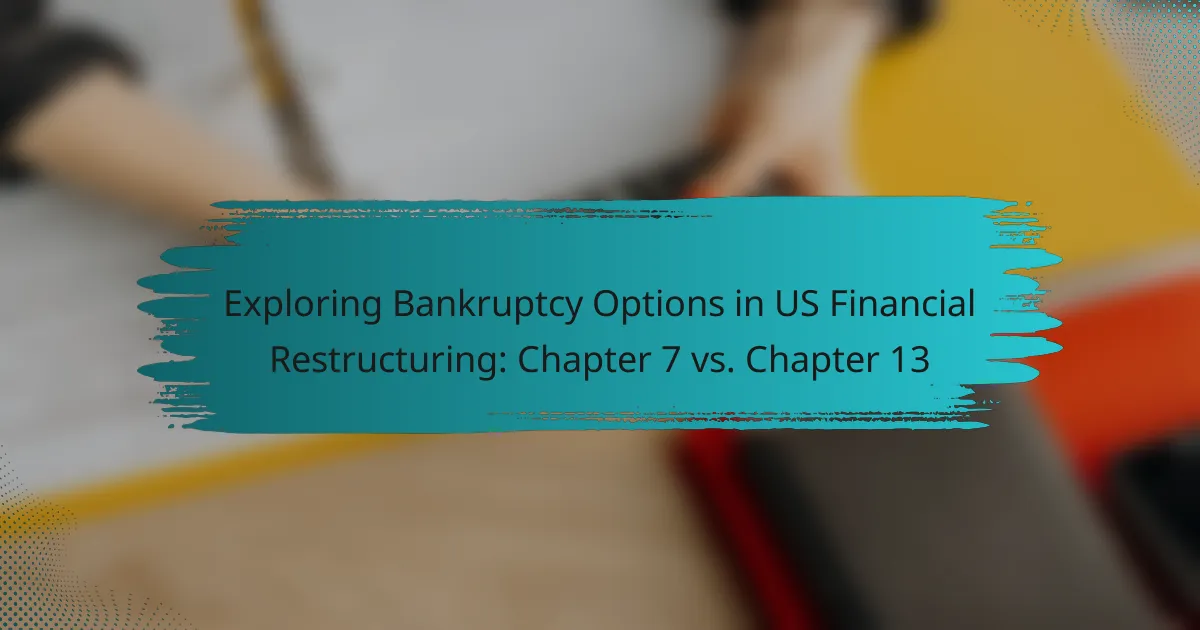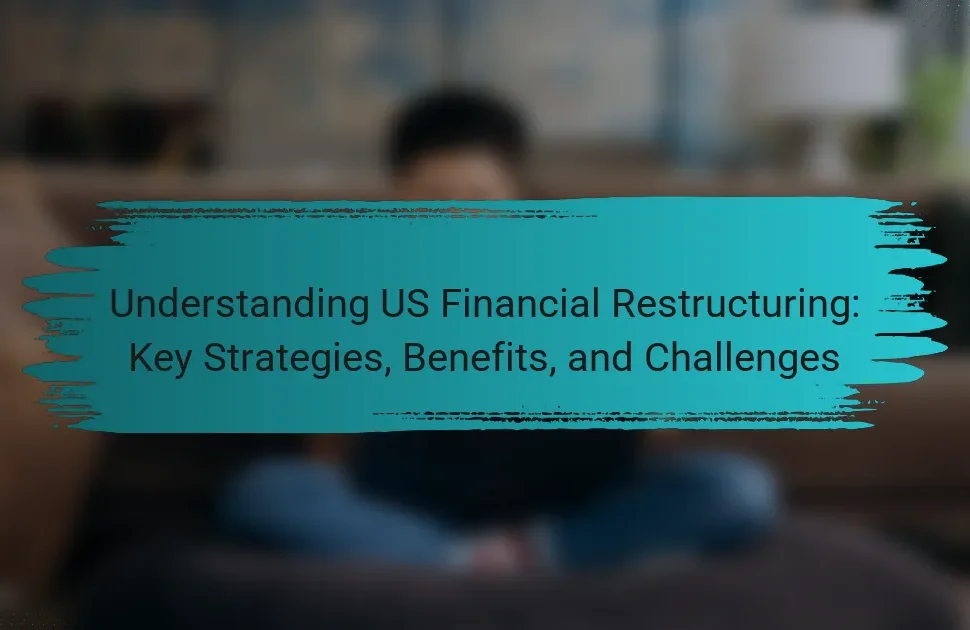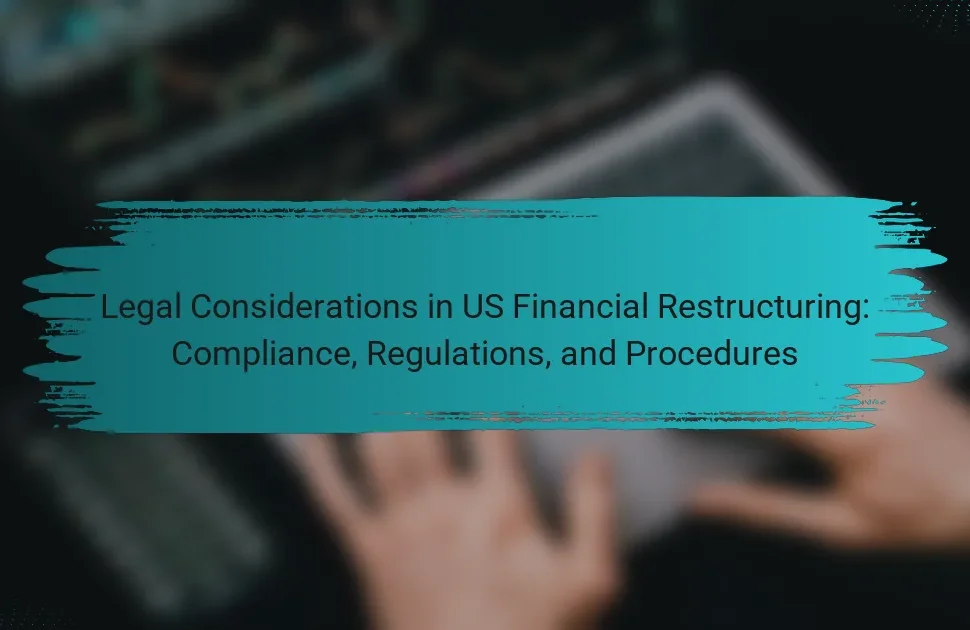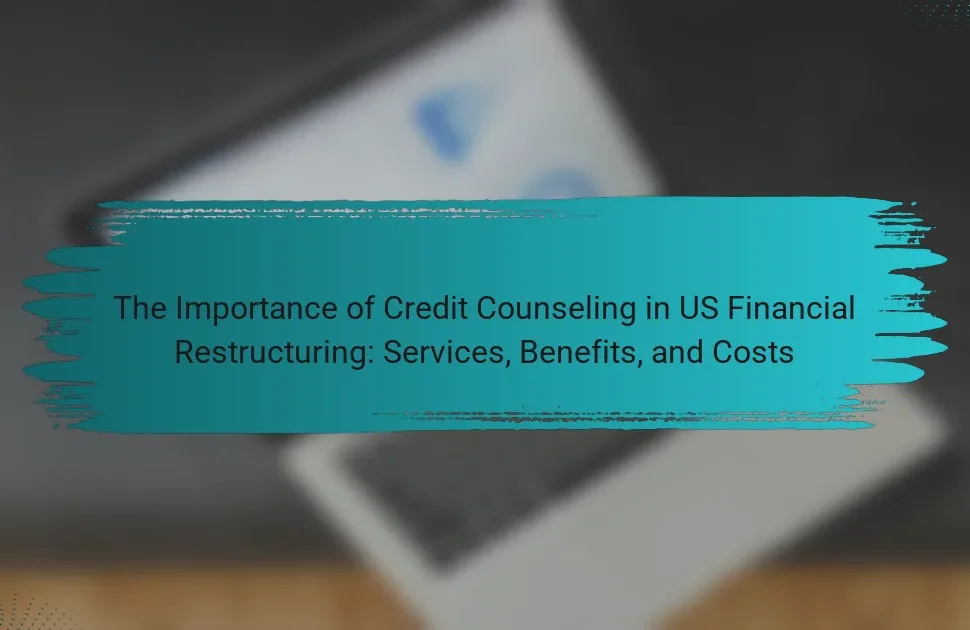Bankruptcy options in the United States primarily include Chapter 7 and Chapter 13, each catering to different financial situations. Chapter 7 allows individuals to liquidate non-exempt assets to pay creditors, resulting in the discharge of most unsecured debts, making it suitable for those with limited income. In contrast, Chapter 13 enables individuals with a regular income to create a repayment plan over three to five years, allowing them to retain their assets while addressing their debts. Both bankruptcy options provide legal protection from creditors but come with distinct benefits and drawbacks that impact credit scores and asset retention.
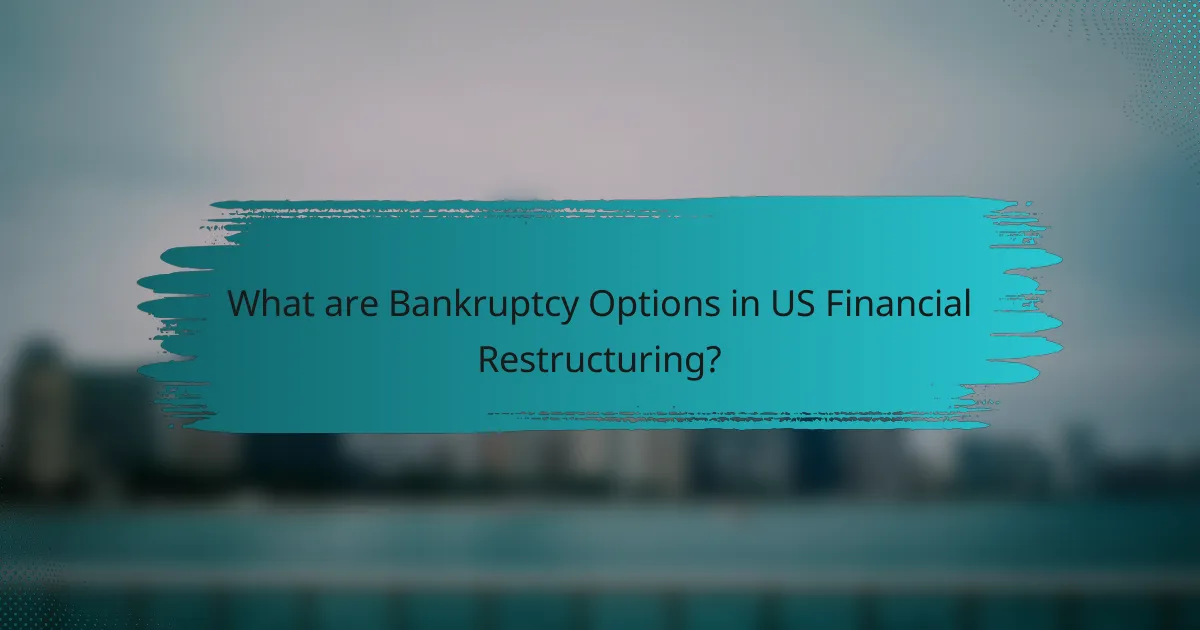
What are Bankruptcy Options in US Financial Restructuring?
Bankruptcy options in US financial restructuring primarily include Chapter 7 and Chapter 13. Chapter 7 allows for liquidation of non-exempt assets to pay creditors. It typically results in the discharge of most unsecured debts. This option is suitable for individuals with limited income and significant debt. Chapter 13 involves a repayment plan to pay back all or part of debts over three to five years. It is designed for individuals with a regular income who wish to keep their assets. Both options provide legal protection from creditors during the bankruptcy process.
How do Chapter 7 and Chapter 13 bankruptcy differ?
Chapter 7 and Chapter 13 bankruptcy differ primarily in their structure and repayment requirements. Chapter 7 bankruptcy is a liquidation process. It allows individuals to discharge most unsecured debts quickly. In contrast, Chapter 13 bankruptcy is a reorganization process. It requires individuals to create a repayment plan to pay back all or part of their debts over three to five years.
In Chapter 7, non-exempt assets may be sold to pay creditors. However, many personal assets can be exempted, allowing individuals to retain essential property. Chapter 13 allows individuals to keep their property while making monthly payments according to their income.
Eligibility for Chapter 7 is determined by a means test, which assesses income and expenses. Chapter 13 requires a regular income to qualify, as it is based on the ability to make payments.
Overall, Chapter 7 offers a quicker discharge of debts, while Chapter 13 provides a structured repayment plan that helps individuals keep their assets.
What are the key characteristics of Chapter 7 bankruptcy?
Chapter 7 bankruptcy is a legal process that allows individuals to eliminate most unsecured debts. This type of bankruptcy is often referred to as “liquidation bankruptcy.” In Chapter 7, a trustee is appointed to oversee the process. The trustee sells non-exempt assets to pay creditors. Most unsecured debts, like credit card debt, can be discharged. However, certain debts, such as student loans and taxes, are typically not discharged. Eligibility for Chapter 7 requires passing a means test based on income. This process usually takes three to six months to complete.
What are the key characteristics of Chapter 13 bankruptcy?
Chapter 13 bankruptcy allows individuals to reorganize their debts. It requires a repayment plan over three to five years. Debtors can keep their property while making payments. This type of bankruptcy is designed for individuals with a regular income. It is available to those whose unsecured debts are below $465,275 and secured debts are below $1,395,875. Chapter 13 can stop foreclosure and allow debtors to catch up on missed payments. It also protects co-signers from collection actions. This bankruptcy type can improve credit scores over time as debts are repaid.
Why might individuals choose bankruptcy as a financial option?
Individuals might choose bankruptcy as a financial option to eliminate overwhelming debt. Bankruptcy provides a legal process to discharge certain debts and offers a fresh financial start. Chapter 7 bankruptcy allows for the liquidation of non-exempt assets to pay creditors. This option is often chosen for its speed, typically completing within a few months. Chapter 13 bankruptcy enables individuals to reorganize their debts into a manageable repayment plan. This option is preferred by those who want to keep their assets while repaying debts over three to five years. According to the American Bankruptcy Institute, over 700,000 individuals filed for bankruptcy in 2020, indicating its prevalence as a financial solution.
What common financial situations lead to bankruptcy?
Common financial situations that lead to bankruptcy include overwhelming medical expenses, job loss, and excessive debt. Medical bills can accumulate rapidly, leading to financial strain. Job loss reduces income, making it challenging to meet financial obligations. Excessive debt, particularly from credit cards or loans, can become unmanageable. These situations often result in individuals being unable to pay their bills. According to the American Journal of Public Health, nearly 66.5% of bankruptcies are tied to medical issues. Additionally, the U.S. Bureau of Labor Statistics reports that job loss can lead to significant financial distress.
How does bankruptcy impact credit scores?
Bankruptcy significantly lowers credit scores. A Chapter 7 bankruptcy can drop a credit score by 130 to 240 points. This decrease can remain on a credit report for up to 10 years. A Chapter 13 bankruptcy typically results in a smaller score drop, around 100 to 200 points. It stays on the credit report for 7 years. The impact on credit scores varies based on individual credit history. Rebuilding credit is possible after bankruptcy through responsible financial behavior.
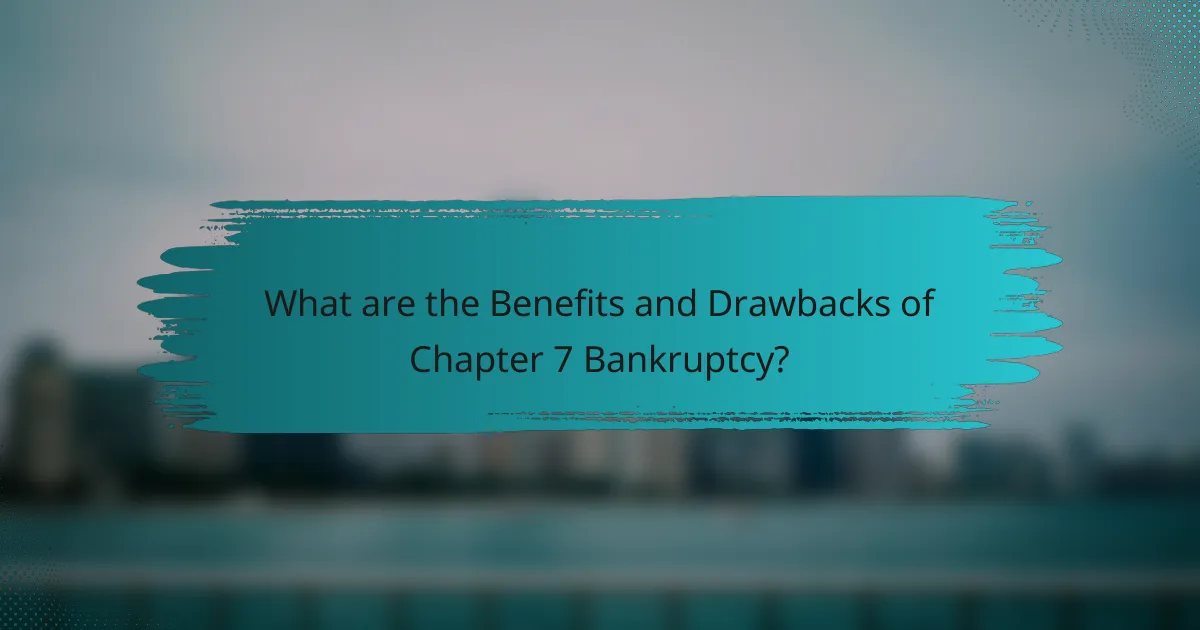
What are the Benefits and Drawbacks of Chapter 7 Bankruptcy?
Chapter 7 bankruptcy provides benefits and drawbacks. The primary benefit is the discharge of unsecured debts, allowing individuals to start fresh financially. It typically takes three to six months to complete the process. This type of bankruptcy is often quicker and less expensive than other forms. However, it also has significant drawbacks. Individuals may lose non-exempt assets, which can include property and savings. Chapter 7 bankruptcy can severely impact credit scores, lasting up to ten years. Furthermore, not all debts are dischargeable, such as student loans and tax obligations. Individuals must also qualify based on income and pass the means test.
What are the advantages of filing for Chapter 7 bankruptcy?
Filing for Chapter 7 bankruptcy provides several advantages. It allows for the discharge of most unsecured debts, such as credit card bills and medical expenses. This process typically takes three to six months, providing quick relief to debtors. Chapter 7 bankruptcy offers a fresh financial start, enabling individuals to rebuild their credit sooner. Additionally, it protects certain exempt assets from liquidation, allowing individuals to retain essential property. According to the U.S. Courts, approximately 90% of Chapter 7 cases result in debt discharge. This high success rate underscores its effectiveness in debt resolution.
How does Chapter 7 provide a fresh start financially?
Chapter 7 provides a fresh start financially by discharging most unsecured debts. This allows individuals to eliminate burdensome financial obligations. Key debts that can be discharged include credit card debt, medical bills, and personal loans. The process typically takes three to six months. Upon discharge, individuals are no longer legally required to pay these debts. This relief can significantly improve financial stability and credit score over time. Additionally, Chapter 7 allows individuals to keep certain exempt assets, further aiding in their financial recovery. By providing this clean slate, Chapter 7 helps individuals regain control of their financial situation.
What debts can be discharged under Chapter 7?
Chapter 7 bankruptcy can discharge unsecured debts. This includes credit card debt, medical bills, and personal loans. Certain types of tax debts and student loans are typically not dischargeable. Additionally, debts arising from fraud or willful misconduct cannot be eliminated. The discharge process provides relief for individuals unable to repay these debts. According to the U.S. Bankruptcy Code, eligible debts are wiped out, allowing for a fresh financial start.
What are the disadvantages of Chapter 7 bankruptcy?
Chapter 7 bankruptcy has several disadvantages. It leads to the loss of non-exempt assets. This means individuals may have to forfeit valuable property to pay creditors. It also results in a significant impact on credit scores. A Chapter 7 filing can remain on a credit report for up to ten years. Additionally, individuals may face difficulties in obtaining future credit. Lenders often view Chapter 7 filers as high-risk borrowers. Moreover, it does not eliminate certain types of debts. Obligations like student loans and child support typically remain after filing. Finally, there are eligibility requirements that may exclude some individuals. Not everyone qualifies for Chapter 7 bankruptcy based on income levels.
What assets might be lost during a Chapter 7 filing?
During a Chapter 7 filing, non-exempt assets may be lost. These assets can include luxury items, second homes, and valuable collectibles. The bankruptcy trustee may sell these assets to pay creditors. Exemptions vary by state and can protect certain types of property. Common exempt assets often include a primary residence, personal belongings, and retirement accounts. However, the specifics of what can be lost depend on the individual’s financial situation and state laws. Understanding these factors is crucial for anyone considering Chapter 7 bankruptcy.
How does Chapter 7 affect future credit opportunities?
Filing for Chapter 7 bankruptcy significantly impacts future credit opportunities. It typically remains on a credit report for up to 10 years. During this time, obtaining new credit can be challenging. Lenders may view Chapter 7 as a sign of financial irresponsibility. Interest rates on loans may be higher for individuals with a bankruptcy record. However, some lenders specialize in offering credit to those with bankruptcies. Rebuilding credit can begin immediately after the bankruptcy discharge. Responsible use of secured credit cards or small loans can help improve credit scores over time.
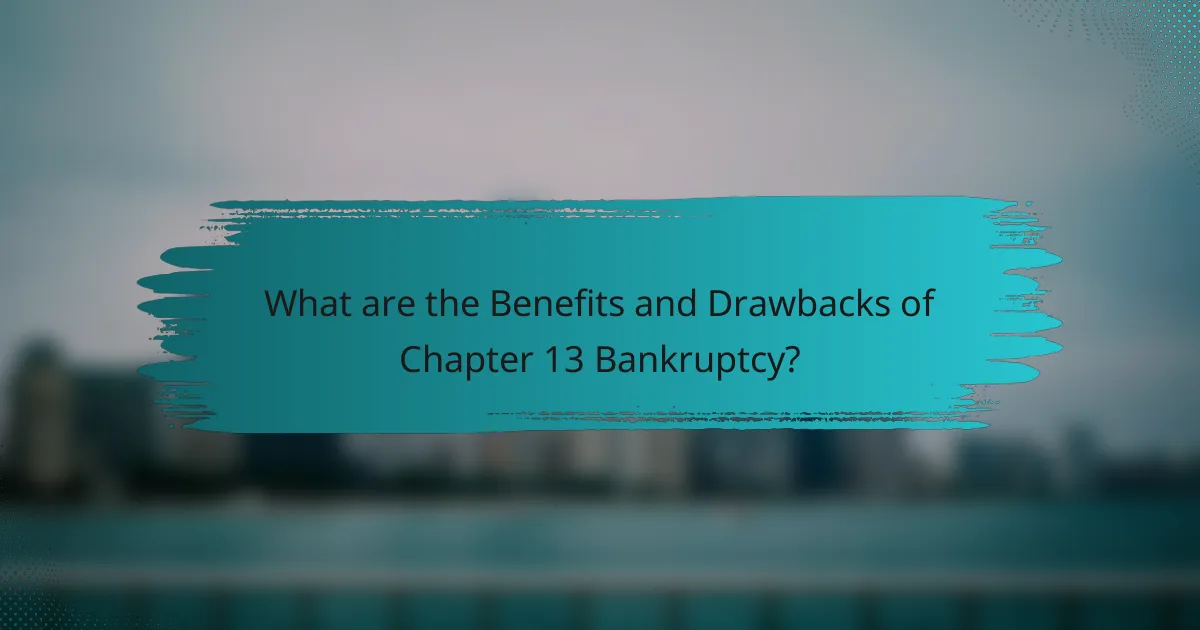
What are the Benefits and Drawbacks of Chapter 13 Bankruptcy?
Chapter 13 bankruptcy offers several benefits and drawbacks. The primary benefit is that it allows individuals to keep their assets while reorganizing their debts. This is particularly advantageous for those facing foreclosure. Another benefit is the ability to create a manageable repayment plan over three to five years. This structured approach can lead to a discharge of remaining unsecured debts after the repayment period.
However, there are drawbacks to consider. One significant drawback is the impact on credit scores, which can remain negative for up to seven years. Additionally, individuals must have a regular income to qualify for Chapter 13, limiting access for some. The repayment plan can also be financially burdensome, as it may require higher monthly payments compared to other bankruptcy options.
What are the advantages of filing for Chapter 13 bankruptcy?
Filing for Chapter 13 bankruptcy offers several advantages. It allows individuals to keep their property while reorganizing debt. Chapter 13 creates a structured repayment plan over three to five years. This plan is often more manageable than lump-sum payments. Individuals can catch up on missed mortgage or car payments. It protects against foreclosure and repossession during the repayment period. Additionally, Chapter 13 can help eliminate unsecured debts after completing the plan. This process can improve credit scores over time as debts are paid down.
How does Chapter 13 allow for debt repayment plans?
Chapter 13 allows for debt repayment plans by enabling individuals to propose a structured repayment schedule. This plan typically spans three to five years. During this period, debtors make regular payments to a bankruptcy trustee. The trustee then distributes these payments to creditors. Chapter 13 is designed for individuals with a regular income. It helps them retain their assets while repaying debts over time. The plan must be approved by the bankruptcy court. This approval ensures that the repayment plan is feasible and fair to creditors.
What protections does Chapter 13 offer against foreclosure?
Chapter 13 offers significant protections against foreclosure by allowing homeowners to reorganize their debts. This bankruptcy option enables individuals to create a repayment plan over three to five years. During this period, foreclosure proceedings are halted, providing a temporary stay on the process. Homeowners can catch up on missed mortgage payments through this plan. Additionally, Chapter 13 allows individuals to keep their homes while addressing other debts. According to the U.S. Bankruptcy Code, this protection is fundamental to the Chapter 13 process.
What are the disadvantages of Chapter 13 bankruptcy?
Chapter 13 bankruptcy has several disadvantages. It requires a repayment plan that lasts three to five years. During this time, debtors must make regular payments to creditors. This can strain personal finances and limit disposable income. Additionally, Chapter 13 may affect credit scores for up to seven years. Not all debts can be discharged, such as certain tax obligations and student loans. Moreover, debtors must have a regular income to qualify, which can exclude those without stable jobs. Lastly, failure to adhere to the repayment plan can lead to dismissal of the case, resulting in no debt relief.
How long does a Chapter 13 repayment plan typically last?
A Chapter 13 repayment plan typically lasts three to five years. The duration is determined by the debtor’s income and the amount of debt. If the debtor’s income is below the state median, the plan lasts three years. If the income exceeds the median, the plan extends to five years. This structure allows debtors to make manageable payments while keeping their assets. The court must approve the repayment plan, ensuring it meets legal requirements.
What are the implications of missed payments in Chapter 13?
Missed payments in Chapter 13 can lead to significant consequences. The most immediate implication is the risk of case dismissal. If a debtor fails to make payments as outlined in the repayment plan, the bankruptcy court may dismiss the case. This dismissal means the debtor loses the protection from creditors provided by the bankruptcy filing.
Additionally, missed payments can result in the loss of property. Secured creditors may seek to reclaim collateral if payments are not made. This is particularly common with mortgages and car loans. Furthermore, the debtor may face challenges in obtaining future credit. A dismissed Chapter 13 case can negatively impact credit scores.
According to the U.S. Courts, maintaining regular payments is crucial for the successful completion of a Chapter 13 plan. Consistent payments demonstrate compliance with the court’s requirements. Thus, missed payments can jeopardize the entire bankruptcy process and the debtor’s financial recovery.
How do I decide between Chapter 7 and Chapter 13 bankruptcy?
To decide between Chapter 7 and Chapter 13 bankruptcy, assess your financial situation and goals. Chapter 7 allows for quick debt discharge and requires passing a means test. It is suitable for individuals with limited income and few assets. Chapter 13 involves a repayment plan over three to five years. It is ideal for those with a steady income who want to keep their assets. Consider your income level, types of debt, and asset protection needs. Chapter 7 can eliminate unsecured debts like credit cards, while Chapter 13 can help with mortgage arrears. Understanding these factors will guide your decision effectively.
What factors should be considered when choosing a bankruptcy type?
When choosing a bankruptcy type, consider the individual’s financial situation, debt types, and asset ownership. Chapter 7 is suitable for those with limited income and unsecured debts. It allows for quicker debt discharge but may require asset liquidation. Chapter 13 is ideal for individuals with a stable income who want to keep their assets. It involves a repayment plan over three to five years. Additionally, the impact on credit scores and eligibility for future loans is important. Understanding the legal requirements and potential exemptions is also crucial. Each bankruptcy type serves different needs and has distinct implications for the debtor’s financial future.
How can consulting a bankruptcy attorney help in making this decision?
Consulting a bankruptcy attorney can provide crucial guidance in deciding between Chapter 7 and Chapter 13 bankruptcy. An attorney can analyze individual financial situations. They assess income, debts, and assets to recommend the best option. Legal expertise helps navigate complex bankruptcy laws. Attorneys can explain the implications of each chapter on credit and asset retention. They also clarify the process, timelines, and potential outcomes. This professional insight reduces the risk of costly mistakes. Ultimately, informed decisions lead to better financial recovery strategies.
What practical steps should I take if considering bankruptcy?
Consult a bankruptcy attorney to understand your options. They can provide tailored advice based on your financial situation. Gather all financial documents, including debts, income, and expenses. This information is crucial for your attorney’s assessment. Consider alternatives to bankruptcy, such as debt consolidation or negotiation. These options may be less damaging to your credit. Evaluate your eligibility for Chapter 7 or Chapter 13 bankruptcy. Each has different requirements and implications. Complete mandatory credit counseling from an approved agency. This step is required before filing for bankruptcy. Prepare to file your bankruptcy petition and schedules with the court. Ensure all information is accurate and complete. Attend the 341 meeting of creditors after filing. This meeting allows creditors to ask questions about your finances. Follow through with any required financial management courses. This is mandatory for completing the bankruptcy process.
The main entity of this article is bankruptcy options in US financial restructuring, specifically focusing on Chapter 7 and Chapter 13. Chapter 7 allows for the liquidation of non-exempt assets to discharge most unsecured debts, making it suitable for individuals with limited income. In contrast, Chapter 13 involves creating a repayment plan over three to five years, enabling individuals to retain their assets while addressing their debts. The article will explore the differences between these bankruptcy types, their eligibility requirements, benefits and drawbacks, and the impact on credit scores, providing a comprehensive understanding of financial restructuring options available to individuals facing overwhelming debt.
